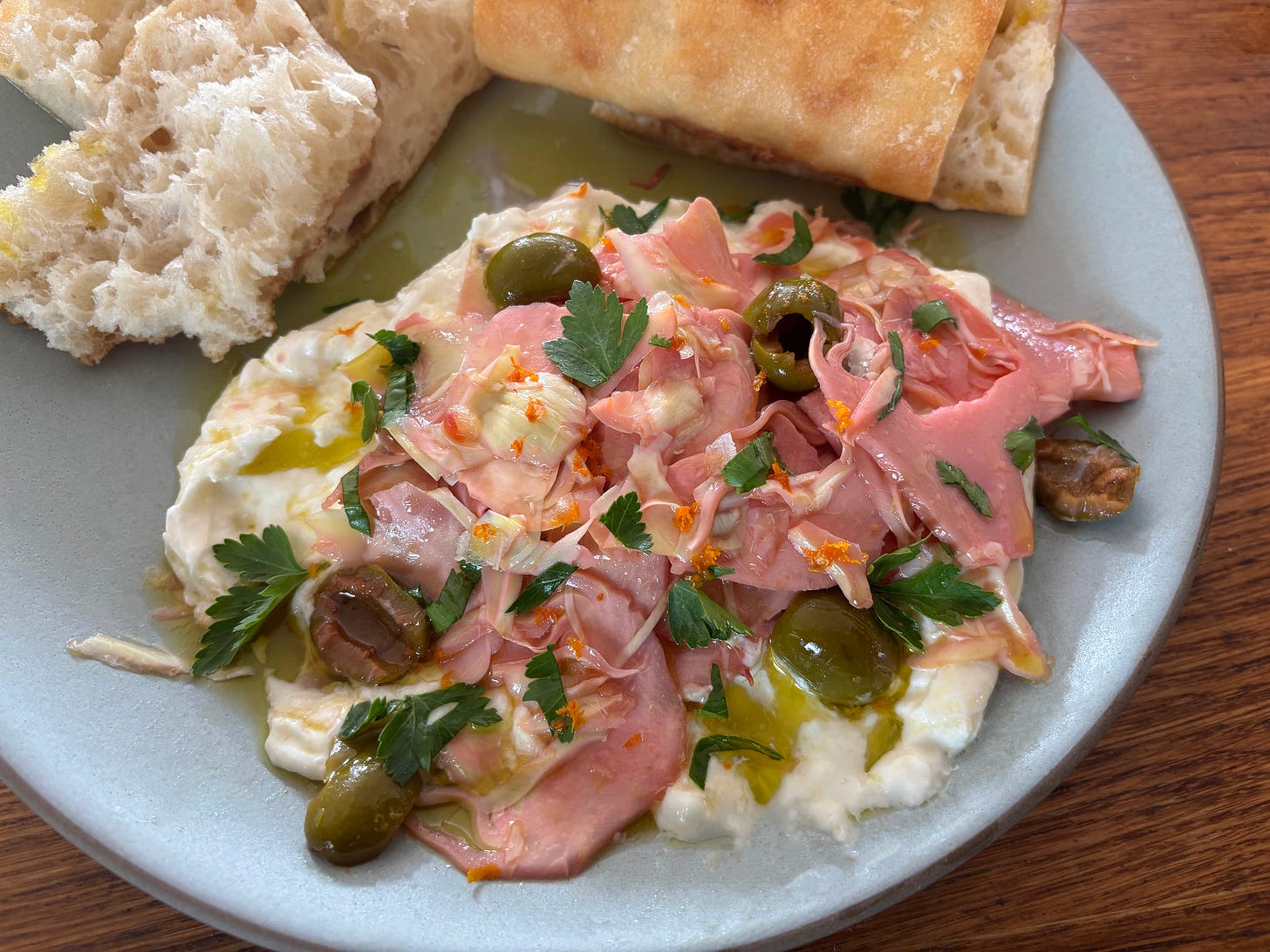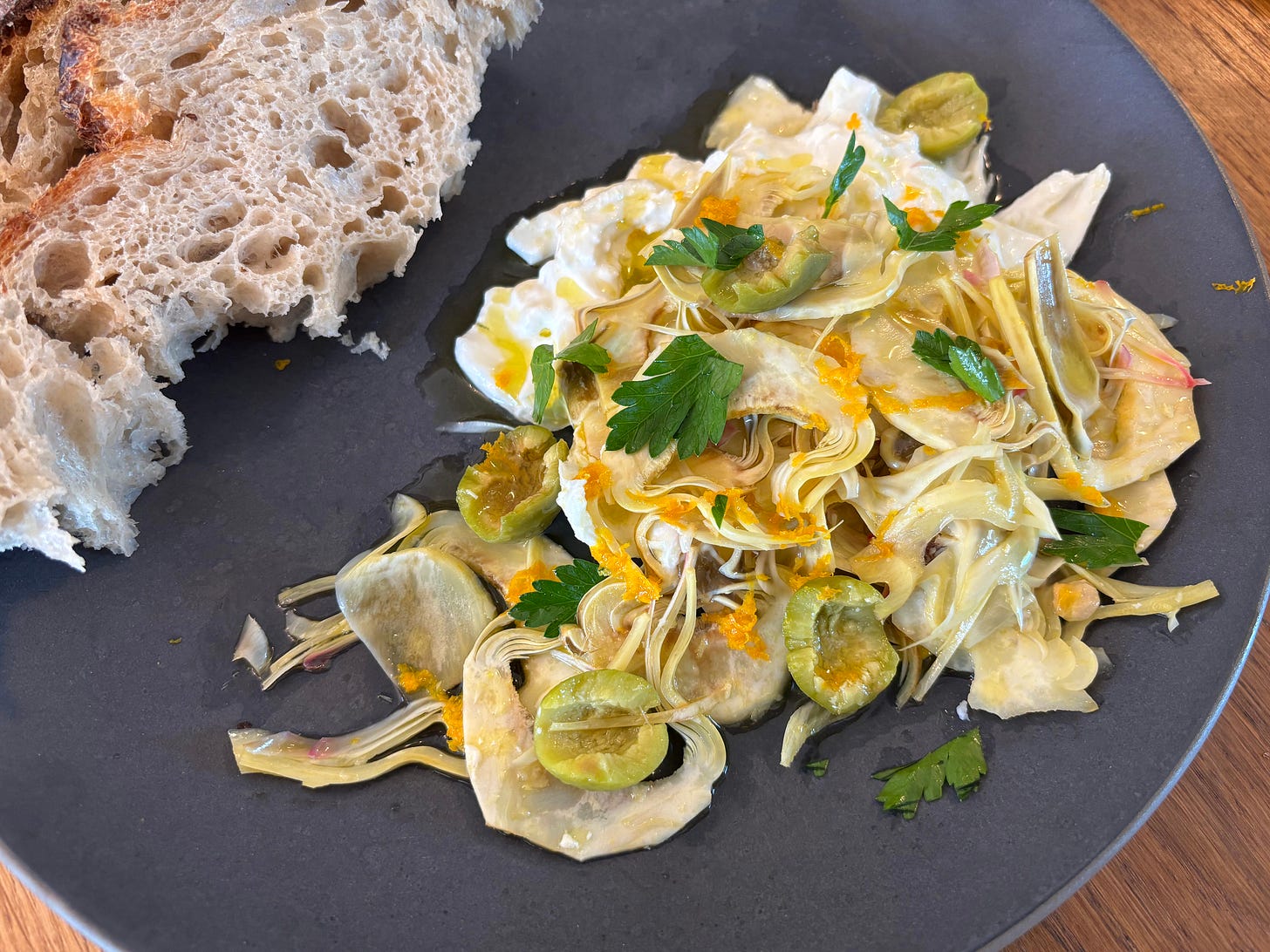Citrusy Artichoke Hearts with Burrata
Enjoying the last of winter's flavors in a bright, creamy snack
One of my absolute favorite things about living in California is easy access to all kinds of citrus in the cold winter months as well as to fresh artichokes grown just a couple hours away in Castroville, the “artichoke capital of the world.” Thankfully, just because it’s spring doesn’t mean I have to give up on these ingredients—citrus season is winding down a bit, but there are still plenty of oranges and mandarins in the market (and waaaaaay too many Meyer lemons on my tree). And early spring is actually peak artichoke season at nearby farms.
While I love serving artichokes whole—steaming them and bringing them to the table just as they are, with some aioli or butter in a little bowl to dip the tender parts of the leaves into—I occasionally take the extra step of trimming off the tough parts of the leaves and stems to use just the tender hearts in an interesting and different way. Here, I’ve shaved them thin and flavored them in a lemon-orange marinade (heated just a bit, to speed the process up) and piled them onto creamy burrata with some Castelvetrano olives. The artichokes have a lovely, tender bite to them, which contrasts with the cheese’s creaminess, and the combination of citrus and olives gives the whole thing a bright flavor. To eat this mixture, I just pile bites of it into some good bread, like this loaf from Tartine or some pizza bianca from Acme Bakery.
My new book, SNACKING DINNERS, launched last month! Check out my book events page for upcoming talks, signings, and pop-ups in the Bay Area, New York, London, and more!
Trimming the artichoke is actually a lot easier and faster than you’d think it would be; once you’ve done it a couple times, you’ll be surprised at how simple the process actually is. (You can see how I do it here.) That said, you can also get a similar result with 4–5 ounces brined artichoke hearts, though the flavor and texture won’t be quite the same. (If you opt to use canned artichoke hearts, don’t simmer them in the seasoning or they’ll get too soft; just heat the citrus and oil and pour them over the hearts to steep for a few minutes.)
The marinade I’ve used here is based on the dressing Leah Koenig has in her lovely book Portico. She leaves her artichokes in the citrus mixture for a minimum of 30 minutes and all the way up to a full day, so that the flavors can penetrate, then serves them as a carpaccio-like salad topped with parmesan. I speed things up by heating the mixture up for a few minutes, which also softens the artichokes a bit, so their texture works well with the burrata. Both options are delicious!

Citrusy Artichoke Carpaccio with Burrata
¼ cup fresh lemon juice
¼ cup fresh orange juice (reserve the peels for zest)
¼ cup extra virgin olive oil, plus more for drizzling
1 small garlic clove
1 large globe artichoke
3–4 pitted mild green olives, such as Castelvetrano
1 ball burrata
Flakey sea salt and parsley, for finishing
Rustic bread
Mix the lemon and orange juices and the olive oil in a small pot and grate in the garlic using a microplane zester (or mince the garlic and add it).
Trim an artichoke to remove the outer leaves and stems, then cut the center in half and scoop out the choke, so you only have the heart. (See method here.) Using a mandolin or a sharp knife, cut the artichoke heart halves into very thin slices, putting each slice straight into the citrus-olive oil mix to keep it from browning. Tear the olives in half and add them to the mixture.
Transfer the pot to the stove and heat everything until it is bubbling. Let the mixture cook for a minute or so, then remove it from the heat; this will help the flavors penetrate the artichoke.
Drain the burrata and set it on a plate, then use a fork to pull it open, exposing the cream in the center. Pile the artichoke and olives (without the marinade) onto the burrata and top everything with finely grated orange zest, a drizzle of olive oil, a big pinch of salt, and some parsley. Eat the cheese and artichoke slices piled onto pieces of rustic bread.
Photos: Georgia Freedman




PS - I brought Snacking Dinners as a host gift this weekend and it was INSTANTLY LOVED 💗
wow, this looks so incredible. must remember to get artichokes at the farmers market